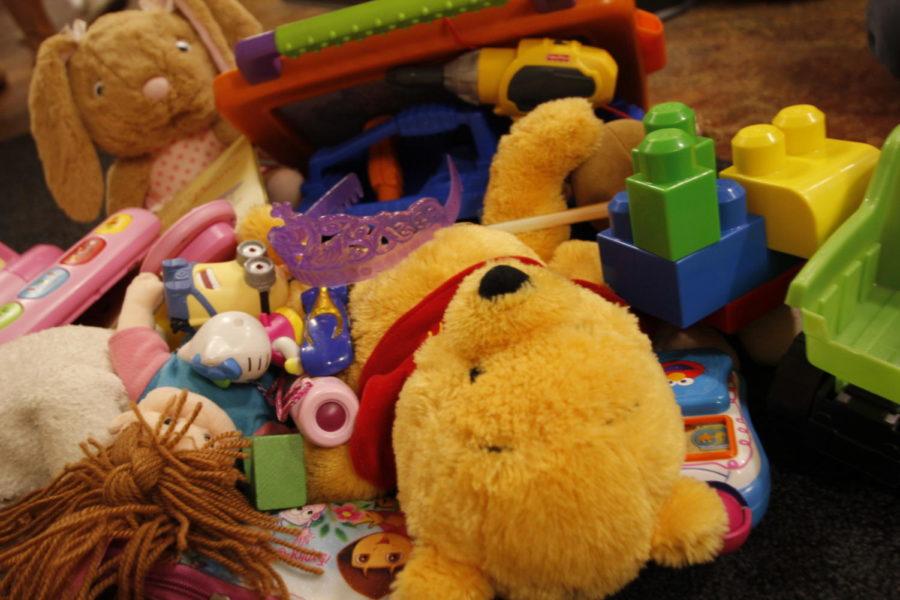Godfrey: Children’s toys push girls out of STEM fields
Jonathan Krueger/Iowa State Daily
Children’s toys tend to have sexist qualities that make it seem children must fit social norms. Often, toys don’t give girls reason to explore spatial learning skills that lead into STEM related fields.
September 5, 2013
Welcome to Iowa State University of Science and Technology — the historic and beautiful land-grant institution, where only a small fraction of its female students actually study “science and technology.”
This isn’t just a phenomenon here at Iowa State. Females are way outnumbered in the STEM fields (disciplines which include science, technology, engineering and math) all across the country.
That’s not news to anyone. Men have dominated the technical realm since, well, ever. And although more women are gradually starting to take interest in these topics, according to ForbesWoman, there hasn’t been a lot of real growth in the employment of women in STEM jobs.
Many scientists and scholars speculate that girls just aren’t pushed to enter STEM fields in primary school the way boys are — and that a male-dominated work environment discourages them from even trying.
And these experts aren’t wrong, but I would say the problem starts much earlier.
The problem begins with our toys.
Girls’ spatial learning development, career goals and even their perspective on life are all influenced by the toys they play with during early childhood. And although young women should absolutely be encouraged to enter the STEM fields after high school, attempting to garner their interest at age 18 might just be too little, too late.
Childhood is when people begin developing their spatial learning skills; these skills, according to the National Science Foundation, are what allow us to “mentally visualize and manipulate two- and three-dimensional objects.” Having these spatial learning skills is an indicator of “talent in science, technology, engineering and math.” Examples of spatial learning toys include blocks, puzzles and building sets, which teach children how to work with shapes and understand rotation — concepts used by engineers and mathematicians.
Let’s look at a few toys from the Toys R Us website. It’s important to mention that the girls’ and boys’ toys are, indeed, separately labeled.
Under the “building sets” category:
For girls: Lego Friends Olivia’s House, Treasure Hunt in Heartlake City and Cra-Z-Art Lite Brix Sparkle Salon, available in “Radiant Runway” edition.
For boys: Lego City Space Shuttle, “Builders of Tomorrow” set, Lego City Space Center, Lego City Forest Police Station, Passenger Train and Fire Brigade.
Under the “preschool age” category:
For girls: You & Me Hugs & Holds doll, You & Me Baby Doll cuddle carrier, and the Just Like Home Dirt Devil Junior Upright Vacuum.
For boys: Digging For Dinosaurs Leapfrog Explorer Learning Game and the Fisher Price Imaginext Tri-County Landfill.
At Toys R Us, girls have an extra category: “Bath, Beauty and Accessories.” Boys do not.
These examples all come from the first page of the Toys R Us website, implying that these selections are their most heavily-marketed and their most popular. And although I didn’t complete a full product analysis, it’s easy to see from a few examples that toys for girls are not really designed to get them interested in science and math.
There are 11 different building sets available for girls — 47 for boys. When it comes to preschool development, boys get science-based toys, models and tools.
Girls get “cuddle carriers” and vacuums. These toys have very few “spatial learning” characteristics.
This week, I spoke with 10 female students at Iowa State, and of those young women, only one said she played with mainly spatial learning toys like blocks and building sets as a child; only four considered themselves to be “tech-savvy,” and only three said they actually enjoyed working with numbers, technology or science.
A whopping zero out of the 10 was majoring in a tech-related, engineering or math field.
Here at Iowa State, the College of Engineering has the largest gender disparity, with only 15 percent female enrollment. According to the Office of the Registrar, there are 134 female students enrolled in civil engineering, compared with 610 males; 57 females in electrical engineering, next to 523 males; and 143 female mechanical engineering students studying with 1,360 male mechanical engineers.
The point here is not that girls can’t do math or science — or that they are somehow incapable of working in STEM fields. That’s simply untrue.
But it is statistically more difficult to find women studying in these fields than men, and we can’t blame it on anyone but ourselves.
Primary schools should be stressing math and science curriculum — and universities must encourage female students to join their engineering programs. But we need to start even earlier to truly have an influence on the development of our children.
Because what they play with makes them who they are.






